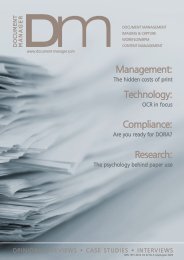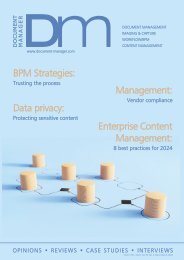NC Feb-Mar 2023
Create successful ePaper yourself
Turn your PDF publications into a flip-book with our unique Google optimized e-Paper software.
FEATURE: HYBRID WORKNG<br />
technology without frustration: they want the<br />
latest digital tools that seamlessly fit around<br />
the job they do without slowing them down or<br />
getting in their way. As the war for talent<br />
heats up - and a new generation of digital<br />
natives join the workforce in ever-growing<br />
numbers - businesses must continually<br />
modernise to attract and retain great<br />
employees. Therefore, organisations in <strong>2023</strong><br />
simply cannot afford to frustrate their staff<br />
with outdated, inflexible technology.<br />
This year will see businesses increasingly<br />
turn to collaborative technological tools to<br />
close the gap between office-based working<br />
and remote working. Offices will be fitted<br />
with technologies that allow for the best<br />
blend between physical and virtual<br />
participation, ensuring a seamless, highquality<br />
audio-visual experience that enables<br />
everyone to feel included in a shared working<br />
environment. When remote employees feel<br />
just as comfortable, productive, and<br />
supported working virtually as they would in<br />
an office, the most inspiring collaborative<br />
work can take shape.<br />
EFFECTIVE COMMUNICATION IS KEY<br />
However, it is not enough just to kit employees<br />
with the right digital tools. Business leaders<br />
will also need to think carefully about how<br />
they can communicate effectively with an<br />
employee base that's more fluid, mobile, and<br />
geographically dispersed than before.<br />
As new ways of working continue to blur the<br />
lines between work life and home life, the<br />
expansion of the virtual workforce means that<br />
many businesses now rely more heavily on<br />
email interaction than on face-to-face<br />
communication. This is resulting in remote<br />
and hybrid workers getting their inboxes<br />
flooded with emails. In fact, the average office<br />
worker is said to receive more than 120<br />
emails daily - and many remote employees<br />
are feeling compelled to check their work<br />
emails multiple times outside of their<br />
contracted hours.<br />
The simple truth is that by<br />
overcommunicating with their employees,<br />
businesses risk not communicating at all. The<br />
process of wading through a mountain of<br />
emails just to find that one message that<br />
needs dealing with is a frustration that most<br />
workers can relate to, and email overload<br />
threatens to fuel the employer-employee<br />
disconnect. Employers need to ensure that<br />
their most important correspondence with<br />
employees is not diluted or drowned in all of<br />
the noise.<br />
This is why process efficiency and stronger<br />
communication will be key management<br />
priorities in the months ahead. Technology<br />
plays a pivotal role in establishing a more<br />
streamlined and clear communication process<br />
in a hybrid working environment. For example,<br />
group chat software can be a helpful tool for<br />
managers to keep themselves available, be<br />
transparent about expectations, and share<br />
regular updates with physically dispersed<br />
teams, ensuring that everybody is consistently<br />
in the loop.<br />
GOING BESPOKE<br />
This year will also see the development of<br />
apps that allow organisations to create<br />
efficiency and be more flexible - on their own<br />
terms. Many of these applications will be<br />
custom-made to meet specific business<br />
processes and needs.<br />
While off-the-shelf applications offer<br />
organisations some useful functions, such as<br />
simple task tracking or calendar management,<br />
they are increasingly being recognised as a<br />
quick-fix solution to much longer-term<br />
business needs. In contrast, bespoke apps are<br />
custom built to support businesses with each<br />
of their specific requirements, adapting<br />
alongside the company as their needs evolve<br />
over time. This flexibility empowers<br />
organisations to meet more complex<br />
objectives, such as improving employee<br />
engagement and enhancing collaboration<br />
across departments.<br />
Therefore, to bridge the employeremployee<br />
gap, businesses are set to<br />
prioritise the need to quickly scale and adapt<br />
to meet current and future challenges. In<br />
many cases, this will bring about a shift away<br />
from off-the-shelf applications and towards<br />
more bespoke solutions to support their own<br />
ways of working.<br />
THE POWER OF SMART<br />
OUTSOURCING<br />
So, how can businesses seize these<br />
opportunities and navigate the complexity of<br />
the workplace in <strong>2023</strong>? With skills shortages<br />
across the IT sector bringing additional<br />
challenges around securing the future of<br />
hybrid working, companies are now looking<br />
towards new solutions to plug the gaps.<br />
As a result, businesses are increasingly<br />
leveraging specialist outsourcing services.<br />
Bringing in a trusted third party to take care of<br />
the entire IT lifecycle - from procurement and<br />
imaging to end-of-life support, data erase,<br />
and repurposing - can give organisations the<br />
breathing space to focus on making the new<br />
normal of work truly work for all employees -<br />
no matter where they are located. Not only<br />
does this process allow companies to<br />
repurpose their in-house capability, but it also<br />
helps to establish and maintain a more<br />
sustainable circular economy - something that<br />
employees are increasingly coming to expect<br />
from the businesses they work for.<br />
Smart outsourcing is helping to relieve the<br />
pressures on internal IT teams, stretching<br />
budgets and resources at a time when both<br />
are under strain. But regardless of whether a<br />
businesses opts to outsource or to keep their<br />
workplace services entirely in-house, the role<br />
of technology in shaping the future of work is<br />
beyond dispute. With the right investment and<br />
support in place, organisations can ensure<br />
that digital tools continue to bring out the best<br />
in their hybrid workforces, setting up both<br />
employers and employees for sustained<br />
success through <strong>2023</strong> and beyond. <strong>NC</strong><br />
WWW.NETWORKCOMPUTING.CO.UK @<strong>NC</strong>MagAndAwards FEBRUARY/MARCH <strong>2023</strong> NETWORKcomputing 19

















